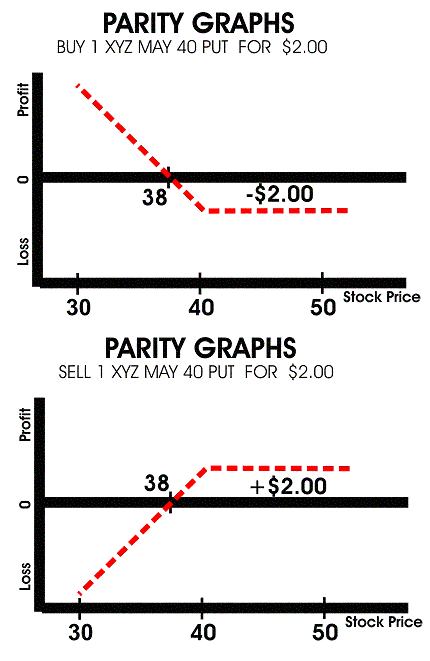
What Are Put Options & How Do They Affect You?Provided By Options University Considerations For Trading Put Options
Put options are contracts between two parties (a buyer and a
seller) whereby the buyer acquires the right but not the obligation
to sell a specified stock or other underlying instrument at
a specified price by a specified date.
If you are selling put options, you must assume the obligation of taking delivery of the stock or other underlying instrument from the buyer should the buyer wish to exercise his option. The put is known as a short instrument which means that the buyer profits from the stock going down. For the seller to profit, the stock must not move below the strike price plus the amount of money received for the sale of the put options. This point is known as the breakeven point and is calculated by adding the calls strike price to the put options premium. Obviously, the buyer hopes that the stock price exceeds the breakeven point. For example, you buy the MSFT January 65 put for $2.00 because you think Microsoft is going to go down. This option gives you the right, but not the obligation to sell the stock at $65.00. In order to obtain this right, you had to spend $2.00. In order for you to make money, the stock would have to trade down below $63.00 by expiration. This is because the stock has to trade down below the strike plus the cost of the put options. If the stock traded down to $60.00, you would make $5.00 because you have the right to sell it at $65.00. However, because you paid $2.00 for the put options, you must subtract that from your $5.00 profit for a total profit of $3.00. You have just made $3.00 on a $2.00 investment. Not a bad return. The buyers of the put options have limited risk and unlimited potential gain. His risk is limited only to the amount of money he spent in purchasing the put options. His unlimited potential gain comes from the stocks unlimited downside potential. The seller, on the other hand, has limited potential gain and unlimited potential loss. The seller can only gain what he was paid for the put options. The unlimited risk comes from the stock prices ability to decline during the life of the contract. For example, if a seller sold the MSFT January 65 put options for $2.00, he is giving the buyer the right to sell 100 shares (per contract) of MSFT to him at $65.00 per share at any time until the put options expire. If MSFT declines and trades down to $55.00, the seller would realize a $10.00 loss less the amount he received for the sale of the option ($2.00), for a net loss of $8.00. Meanwhile, the buyer would realize a $10.00 profit less the amount he paid for the put options ($2.00), for a net gain of $8.00 per contract. If MSFT were to trade up to $75.00, the seller would realize a $2.00 profit (the amount of money he was paid from the buyer). Meanwhile, the buyer would only lose what he paid for the put options ($2.00). The seller is obligated to take delivery of the stock from the buyer at the strike price regardless of the present market price of the stock. This is why the seller receives premium for the sale. Again, the following graphs are called parity graphs. They are intended to show you your put options profit and loss at expiration (when they are trading at parity: i.e. when they are trading without intrinsic value). The first graph shows a put options purchase and the second shows a put sale. The graphs show the amount of your expenditure (in the case of a purchase) or the amount you have received (in the case of a sale) and the dollar price of the stock where you would breakeven. Using the fictitious stock XYZ below, make note of where the stock needs to be at expiration in order for you to be profitable, and how the premium paid (in the case of a purchase) or the premium received (in the case of a sale) affects your profitability. Also notice the difference in the profit potential between a purchase of the put options as opposed to a sale of the put options. Lastly, it is important to note the unlimited potential risk inherent in the sale of the put options, compared to the fixed risk of the put options purchase.
Discover these secret option trading strategies that will have your friends calling YOU 'the options expert' Click here!
copyright 2005 Put Options
|
